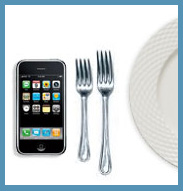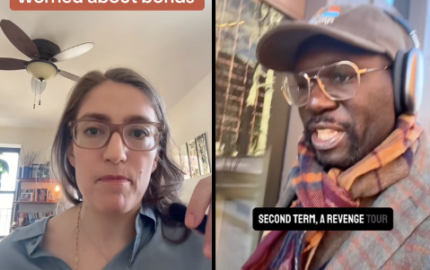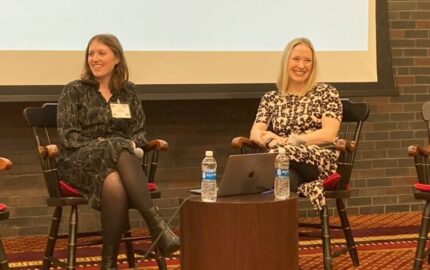You know, the phone.
 It fits in your pocket, why shouldn’t you carry it? It’s always on, why shouldn’t you answer it? Why shouldn’t you text someone the minute you think of something, or check to see what they’re doing? Why shouldn’t you be available, to everyone, all the time?
It fits in your pocket, why shouldn’t you carry it? It’s always on, why shouldn’t you answer it? Why shouldn’t you text someone the minute you think of something, or check to see what they’re doing? Why shouldn’t you be available, to everyone, all the time?Availability at a distance often means rudeness in person. Showing up means you’re already over. Presence pales before possibility. It isn’t good enough to be with who you are with, you should be on your way to the next fabulous party, like Edie Sedgwick and Andy Warhol. Exactly like them, in fact; it’s the Cult of the New writ small, personalized. Anything is meaningful if it’s New. Anything is better if it’s New. Anything is worth having if it’s New.
Except that it isn’t. I don’t mean it isn’t new. I mean it isn’t just consumption. It is a new etiquette. And it is changing not only the stories we tell, but the environment in which they are told — and who feels authorized to tell them.
At its most general, etiquette helps us not kill each other. A negotiation between the self and others, it smoothes rough edges, defuses conflict, and enables a common standard of exchange conducted more in words than steel. Our proximate legacy is the etiquette of the Enlightenment, in which the individual is the ultimate, indivisible unit of civilization, and is treated as such. For example, being with somebody means focusing attention on that person. You respect the discrete nature of the individual by being discreet about the rest. Do you need to make a call or check a message right that minute? No, actually, you don’t; you wait until you have retired, to your office, to your private space, and conduct the rest of your affairs from there.
Etiquette is not just about which fork to use. Or rather, it is — but now it’s fork, fork, cellphone; the vibration of which signals the end of the Enlightenment. Because it signals the end of the individual as we know it.
Too dire? Let’s examine the point. A point is a discrete unit in geometry, intact, inert, perhaps even a little heroic, massing with others of its kind to form lines and planes. A discrete unit, that is; except when it isn’t. Except when it’s the intersection of two lines, or a line and a plane, or a plane and a sphere. And so on. From those perspectives, a point hardly exists at all, it’s just shorthand for the connection between one surface or vector and another. The individual is another such discrete unit. Except when we aren’t. Except when we’re a connection between one space or journey and another. Which is always.
We’ve moved from the etiquette of the individual to the etiquette of the flow.
This is not mob rule, nor is it the fearsome hive mind, the sound of six billion vuvuzelas buzzing. This is not individuals giving up their autonomy or their rational agency. This is individuals choosing to be in touch with each other constantly, exchanging stories and striving for greater connection. The network does not replace the individual, but augments it. We have become individuals-plus-networks, and our ideas immediately have somewhere to go. As a result we’re always having all of our conversations now, flexible geometries of nodes and strands, with links and laughing and gossip and facts flying back and forth. But the real message is movement.
Certain times and locations have been crucibles for the rapid development and proliferation of ideas; for example, 18th century coffeehouses, or the 19th century’s café society. But now we assemble virtually, via the mobile technologies of the conversations themselves. The new coffeehouse is not a place per se, it's a feature.
Eventually I learned to stop worrying and love the flow. The pervasiveness of the new multiplicity, and my participation in it, altered my perspective. Altered my Self. The transition was gradual, but eventually I realized I was on the other side. I was traveling with friends, and one of them took a call. Suddenly, instead of feeling less connected to the people I was with, I felt more connected, both to them and to their friends on the other end of the line (whom I did not know). My perspective had shifted from seeing the call as an interruption to seeing it as an expansion. And I realized that the story I had been telling myself about who I was had widened to include additional narratives, some not “mine,” but which could be felt, at least potentially and in part, personally. A small piece of the global had become, for the moment, local. And once that has happened, it can happen again. The end of the world as we know it? No — it’s the end of the world as I know it, the end of the world as YOU know it — but the beginning of the world as WE know it. The networked self is a verb.
We’re beginning to inhabit ad hoc, overlapping, always-on virtual salons — you’re talking to someone, and then you both get pulled off into different directions, to form different shapes and vectors within the conversations, and then come together again, having never really been apart. You can even have multiple conversations via multiple media with the same person in the same span of time. Single conversations are one-dimensional chess; our language games have increased in complexity. And, potentially, in reward. Because with its ability to feel distant stories in a more personal manner, the expanded self points a way towards those stories becoming more relevant, and perhaps more actionable.
How might this apply to storytelling? It does not necessarily mean that every story must be, or will become, hopelessly fragmented, or that a game mentality can or should replace analysis. It does mean that everyone is potentially a participant in the conversation, instead of just an audience member or consumer at the receiving end. I think the shift in perspective from point to connection enables a wider and more participatory storytelling environment, rather than dictating the shape of stories that flow in the spaces.
Some of those stories include the Enough Fear campaign, which exploited the phone's potential to collapse global distance by setting up phones near the Boston Common, connected to phones in Iran. Passers-by could chat for a few minutes about politics or whatever they wished.
Then there is the “backchannel,” or what Jay Rosen calls by the somewhat unwieldy name of "audience atomization overcome." Common at conferences but not limited to those venues, backchannels are text-based chat streams used to discuss, argue with, or otherwise engage the current talk or event as it occurs. It is a way for members of the audience to host a rapid-fire prototyping of the ideas presented. Twitter is the backchannel medium of the moment, although different technologies have served that purpose in the past. Thanks to Twitter backchannels identified by hashtags, I was able to participate with friends and audience members at some talks at SXSW this past year, despite being unable to attend in person.
Mobile Twitter streams have provided first-person broadcasts from many trouble spots, as well as real-time reactions from emergency situations, as happened on the wing of the U.S. Airways plane that crash-landed in the Hudson River last year. But any mobile communication technology can serve this purpose: in 1996, during the ill-fated Everest expedition where 8 people died in one day, radio and satellite phone enabled guide Rob Hall to place a final call to his wife from where he was stranded just below the summit.
One way to integrate a quantity of first-person reports with a longer and more comprehensive overview is to present them on the same page or site. An article may be accompanied by a scrolling or tiled Twitter stream; for example, the NFL’s Super Bowl XLIV site features input from fans, while ESPN’s Tour de France homepage scrolls comments from participants.
And participation need not be text-based; it might come in the form of different media, such as YouTube videos. Ridley Scott and Kevin Macdonald’s “Life In A Day” asks viewers to help document a single day, July 24, 2010, in the life of the planet and its inhabitants, as does the One Day on Earth project, which is targeting October 10, 2010. Not every submission will make it into the final films, of course; crowdsourcing requires an editorial voice to shape the material. Aggregation is not enough.
What's more, the shape of the story might literally be a shape. Masses of data can be mapped in different ways to reveal underlying themes and unexpected connections. The following two maps use Twitter data to represent which current events are most popular and how happiness levels vary by hour and by state.
Once you master multiplicity, who’s to say how far you will go? Correction: how far we will go. For we will all go together, wherever it is that we are going. Call once you get there!
[This post is an expanded version of a piece Nelson originally wrote for HiLobrow.com. For related thinking, read her earlier posts in this series on Nieman Storyboard.]


